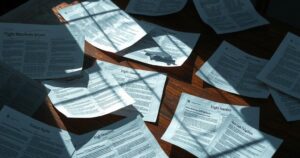Severe Fluctuations in Syrian Pound Challenge Economic Recovery

Syrian pound currency fluctuations post-Assad regime cause uncertainty among traders and businesses, with values shifting sharply from 7,000 to 9,500 pounds per dollar in mere days. Currency manipulation by a small elite complicates recovery efforts. Despite dropping prices in pounds, citizens struggle with purchasing power due to inflation and reliance on dollar remittances, highlighting systemic economic challenges in the region.
In Damascus’s Marjah Square, Rateb Farah sells Syrian pounds from a cardboard box, shouting “Souri, Souri.” Since the end of Assad’s rule, the currency has experienced significant volatility. On some days, he earns $12, but on others, he incurs losses due to unclear exchange rates. Fluctuations saw the pound trade between 7,000 and 9,500 to the dollar within days, complicating business operations in Syria’s evolving economy.
The shift in currency management has presented challenges for Syria’s economy, which faced a large underclass due to monopolistic practices. Following the regime’s fall, the currency’s control diminished overnight, leading to a dollar-based economy where the local currency’s reliability decreased. Previously, mentioning the dollar in these areas could lead to imprisonment, highlighting the drastic changes in currency dynamics.
Currently, one dollar equals about 9,000-10,000 Syrian pounds, a drastic fall from 50 pounds per dollar back in 2011. The Central Bank, now managed by an HTS appointee, has restricted access to local currency deposits, which companies report has led them to pay employees in dollars, creating additional economic challenges. The lack of access to local currency threatens potential recovery for the pound.
Currency traders reveal that a small number of wealthy individuals, termed “whales,” manipulate the market by trading vast amounts of currency. These activities contribute to the currency’s unpredictable conditions, complicating business across the country. Local businesses have had to adapt, with many converting to non-official transfer services to navigate these changes.
Jihad Yazigi from the Syria Report stated that the absence of official money supply data has made it difficult to assess the economy’s health accurately. Past practices of excessive money printing fueled inflation, leaving the new Central Bank to navigate a complex situation for future growth. The challenges of inaccurate exchange rates hinder both investment and consumption in the region.
Since the overthrow of Assad, prices for goods have decreased significantly in regime-controlled areas, but the dollar’s strength remains consistent. Although many products have become affordable, the lack of purchasing power among everyday citizens undermines the potential benefits of these price drops. For example, coffee prices fell sharply in pounds but not in dollar terms, showing that the currency’s instability continues to affect customer spending.
Without consistent economic reforms and enhanced confidence in the Syrian pound, currency gains are unlikely to translate into broader economic recovery. Citizens’ purchasing power remains low despite falling prices, as many households depend primarily on dollar remittances. Therefore, building a stable economy amidst these fluctuations requires addressing deeper systemic issues impacting both currency value and public sentiment.
The article discusses the current economic situation in Syria post-Assad’s regime, focusing on the sharp fluctuations of the Syrian pound against the US dollar and the challenges facing the economy. After the fall of Assad, many traditional controls on currency use disappeared, leading to significant volatility in exchange rates. The involvement of HTS in managing currency further complicates economic conditions, leading to potential recovery strategies amid existing challenges.
In summary, the Syrian economy is currently grappling with severe fluctuations in currency value, impacting daily commerce and creating uncertainty for businesses and individuals. While recent drops in prices may offer some relief, a lack of purchasing power and overall economic stability remains a significant hurdle. Thus, without sustained policy reforms and measures to bolster confidence in the Syrian pound, real recovery may be an elusive goal.
Original Source: www.thenationalnews.com







